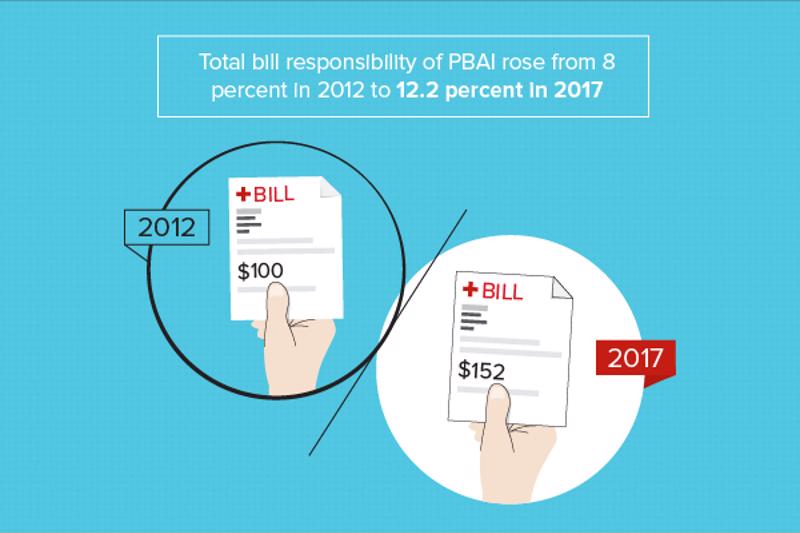Post-health insurance finances burden for patients, study finds
September 14, 2019
A recent study by TransUnion Healthcare found that PBAI challenges continue to grow
Hospitals have faced issues with managing patient balances after insurance usage for years. However, a recent study by TransUnion Healthcare found the challenge continues to grow. Not only is this issue impacting hospitals across the country, but it’s also making it more difficult for patients, posing a serious financial burden on those who can’t afford care costs.
PBAI increasing by the numbers
According to the analysis, total bill responsibility of patient balance after insurance (PBAI) rose from 8 percent in 2012 to 12.2 percent in 2017. Commercially insured patients saw bills rise from an average of $467 to $781, a substantial increase of 67 percent.
“The continued trend in costs is correlating to an increase in uncompensated care.”
Unfortunately, this continued trend in costs is correlating to an increase in uncompensated care, something that impacts both the patient and the provider, according to Jonathan Wiik, author of “Healthcare Revolution: The Patient is the New Payer” and principal for healthcare strategy at TransUnion Healthcare.
“It is becoming clear that patient balances after insurance is a major factor in increases in uncompensated care at the macro level,” said Wiik. “Higher out-of-pocket-costs from cost sharing has made patients responsible for an increasing percentage of the bill. Most patients simply cannot afford that, and hospitals need to make sure they’re actively engaging their patients to ensure they have funding mechanisms for the care needed. Tools like propensity to pay, charity scoring and others can help differentiate a patient’s willingness or ability to pay.”
Medicare patients see costs jump
Medicare patients are also struggling to pay deductibles and coinsurance. Hospitals and facilities are struggling to find a balance between reimbursement and patient responsibility due to this issue, according to John Yount, vice president of TransUnion Healthcare.
“Unpaid medical debt continues to pose challenges and the rise in uncompensated care further reflects the importance of implementing new solutions to prevent revenue leakage, which ultimately provides a better patient financial experience,” said Yount. “A solution to address Medicare Bad Debt reimbursement is another critical component in a hospital’s toolkit to ensure they’re managing to the increased PBAI.”
With the right plan in place, facilities can make better and smarter decisions toward decreasing the financial burden on patients.

Unpaid medical debt poses challenges on patients and the facility.
RCM companies can provide a solution
Making sure the correct payer is identified to maximize reimbursement can solve such issues faced by both the patient and healthcare facility — a good example being an injury from a motor vehicle accident or at work. This is one way to reduce the problem of bad debt exposure, allowing providers to decrease cases of uncompensated care.
Hospitals can benefit from outsourcing to a third-party revenue cycle management company like PROMEDICAL. With a technology-driven revenue cycle partner, you may reduce patient balances after insurance. This minimizes the bad debt and ensures your patients receive the quality care they need without worrying about the financial burden that follows.
Some of the core benefits of working with an RCM provider include a streamlined process, increased efficiency, reduced operating costs and an improved patient experience. There’s no need to rely on just the hospital’s revenue cycle professionals to take care of all revenue cycle management — hire a team of RCM professionals to reduce these tasks.
By partnering with PROMEDICAL, you can improve reimbursement, timely resolutions, and increased cash and, in turn, have more satisfied patients. Reach out to PROMEDICAL today
to learn about the benefits of partnering with our team.

In 2016, healthcare vendors need the most efficient claims processing systems out there. By now, flexible, web-focused methods for important claims tasks are clearly the industry's path forward, and will play a major role in bridging the gap between patients and providers. A fast, digital claims method makes a direct link from implementation to delivery for workers' compensation and motor vehicle billing alike. Now is the time to invest in better revenue cycle management, with a focus on detail-driven, well-facilitated collection that breaks down barriers. Despite the growing pains involved with adopting any new technology, there are a couple of areas where smarter systems have already improved claims processing online. Direct accessibility With each new convenience, the future of healthcare looks more integrated. Data analytics harvests insights from seemingly unrelated details for fuller results. To make this innovation worthwhile, however, there needs to be a distinct pipeline between entities. "Data analytics harvests insight from seemingly unrelated details." Online healthcare portals are already addressing this need, providing direct communication through smart devices like phones and tablets. By bringing necessary information together in a simple, accessible source, these solutions set the stage for clean claims assembly. Shorter cycles Proper collection from the outset can reduce the amount of work hospitals have to do later if the claim is resubmitted, according to Gary Marlow, Vice President of Finance at Beverly Hospital and Addison Gilbert Hospital. "From a revenue cycle perspective, getting the most accurate information up front starts with patient scheduling and patient registration," Marlow told RevCycleIntelligence in 2015. "That provides the groundwork by which claims can be billed and collected in the most efficient and effective manner possible." The way information enters the claims process can impact how it gets managed. If technology, like artificial intelligence, is present at the beginning and guides the claims throughout, there's a consistent system handling the information the process to meet best practices. PROMEDICAL's benefits With our secure, efficient and comprehensive system, PROMEDICAL is staying ahead of the game. We're doing that by developing the following features: Communication: Users can choose from multiple languages with our online offerings. This allows you to customize your system to better reach patient populations and keep claims moving faster. Customization: If our proprietary options aren't currently meeting your needs, we can change them to do so based on feedback. Adapt to state fee schedules or language demands on a case by case basis. Encryption: A must for secure file exchange, PROMEDICAL ensures a secure file transfer process. Our process protects backup data equally strong as primary data, for efficient security across the board. Planning: Organizations also benefit when a set deadline is involved, putting clear limits on when submissions are set for review. Processing records requests within a preordained period of days helps managers know what to expect, and regular reports set up clear overviews of important statistics. Contact PROMEDICAL today to learn more about our healthcare revenue cycle solutions.

According to Pew Research, 15 percent of U.S. adults have used ridesharing services . Where does insurance enter the picture? Uber, Lyft and other ridesharing apps throw a proverbial wrench in hospitals' revenue cycle management operations. Billing is already a major pain point in hospitals – Black Book Research noted most facilities are outsourcing their RCM because in-house teams lack the resources to efficiently handle motor vehicle reimbursement. Ridesharing will only exacerbate the issue. For example, if a rider gets injured and has to go to the hospital, from which institution does the hospital receive reimbursement : The driver's insurance? The passenger's? Uber's? As Uber and Lyft are the most popular ridesharing apps, we'll focus on how these companies handle driver insurance. How do Lyft and Uber insure drivers? Lyft has three types of coverage within its insurance policies: Contingent Liability activates when a driver logs into the app and requests to accept rides – a state Lyft designates as "Driver mode." This coverage provides up to $100,000 per accident for bodily injury. Contingent Comprehensive and Collision kicks in when a driver has picked up a passenger. This coverage applies when a non-collision event damages the driver's vehicle. Uninsured/Underinsured Motorist applies when an at-fault driver who is uninsured or underinsured causes bodily injury to himself, his passengers or any third parties. The coverage provides $1 million per incident, and includes no deductible. For example, if a driver is injured in an accident at a time when he is not working for Lyft, his personal insurance will cover him (assuming he lives in a no-fault state, but that's another issue). However, when the driver activates Driver mode, Lyft's Contingent Liability will protect him even if he hasn't accepted a ride from a passenger. What if the driver's at fault? According to Rideshare Dashboard, Lyft's commercial insurance will cover all damages to third parties and the passenger, but the driver will have to cover his own medical expenses. That's when state laws dictate payment. In Massachusetts, for example, which also happens to be a no-fault state and requires all motor vehicle owners to possess auto insurance, the rider's personal auto insurance will cover the medical bills. Uber's insurance system is somewhat similar to Lyft's but possesses a few minor differences. For example, when an Uber driver is transporting a passenger, and another motorist causes an accident that results in bodily injury to the driver, the passenger and anyone else involved, Uber's UM/UMI will cover bodily injury of anyone in the rideshare vehicle.

With new, transformative technological advancements on the rise, it's no surprise that nearly every industry is feeling the impact of the digital age. From a healthcare provider's perspective, new resources can be used to revamp the current revenue cycle management processes you have in place. To reap the benefits of an optimized approach, you must be willing to take advantage of such emerging technological tools and resources, as stated by Chad Sandefur, Director and Healthcare Analyst at AArete. "Generally speaking, in order to strengthen the revenue cycle management, embracing technology within the revenue cycle is key," Sandefur shared with RevCycleIntelligence.com. "Having the platforms to seamlessly facilitate provider-payer interactions are really integral. In many cases, it's mostly about bad debt avoidance. With that in mind, there are a few specific points." Let's take a closer look at the benefits of utilizing technology, plus some of the emerging resources your facility can use to revamp your current RCM processes: The benefits of an optimized approach By paying attention to the new digital advancements that can benefit your RCM, you can ultimately impact the workflow of your staff members while better streamlining services for consumers. Here are some of the advantages of an optimized approach: Reduced chance for human error – Human error is inevitable when handling large amounts of data. Management software can be used to keep track of patient data input and maintenance. Better opportunity for precise, automated data entry – Between appointment scheduling, data input and claims submission, employees have a lot of duties. Automated software can take care of some of these responsibilities, allowing staff members to better focus on a single task at a time. I ncreased cash flow – Claims management technology can expedite claims quickly and produce clean, accurate claims, ultimately increasing cash flow , as stated by Becker's Hospital Review. Optimizing your RCM approach can lead directly to a significant return on investment and improve the overall reputation of your billing department.
